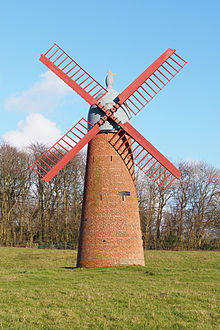 Nashtifan, the ancient city of windmills
Nashtifan, the ancient city of windmills We do know that there were windmills in Iran by the 7th century. These windmills had a long, vertical drive shaft around which rotated six to twelve rectangular, reed-covered sails. This type of device is called a "panemone" windmill.
The first windmills in Northern Europe date from the 1180s and have a very different design. They are called "post" windmills because of the large upright post on which the mill's main structure, the "buck," is balanced so that the mill can rotate to catch the wind when it comes from different directions. The mill was moved using a tailpole or tiller beam that extended from the rear of the body. The picture below, from a 14th century manuscript, shows a post windmill. The two prone figures to the right make me wonder if this illustrates Chaucer's Miller's Tale, but I might be wrong since the text is in Latin and Chaucer wrote in Middle English.
 Fourteenth century windmill image licensed under Public Domain via Wikimedia Commons
Fourteenth century windmill image licensed under Public Domain via Wikimedia Commons It has widely been suggested that returning Crusaders brought the idea of windmills back to Europe with them. While the timing is right, the huge difference in design suggests that this might not be the case, and that windmills might have been designed independently in Europe and the Middle East.

Photo by Francis Franklin (Own work) [CC BY-SA 4.0 (http://creativecommons. org/licenses/by-sa/4.0)], via Wikimedia Commons


